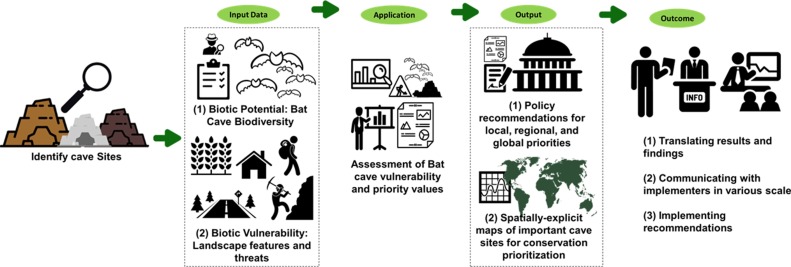Caves and underground habitats are biodiversity hotspots in terms of endemism, yet they receive little conservation attention leaving them vulnerable to exploitation and disturbance. To best maintain and protect current biodiversity, it is essential to develop priorities for conservation and management.
Using bats as umbrella species to evaluate the diversity and conservation needs of caves may provide an index to protect total cave biodiversity.
Researchers from Landscape Ecology Group of Xishuangnanna Tropical Botanical Garden (XTBG) presented the ‘Bat Cave Vulnerability Index’ (BCVI), which is a new approach in using bats as surrogate taxa in prioritising caves. The new holistic approach has been published in Ecological Indicators.
The Biotic Vulnerability is represented by the cave’s landscape features and the presence of human-induced disturbances and threats within and outside the cave. It integrates biodiversity information and habitat condition as fundamental elements in making conservation, management and policy-making initiatives both at regional and global scales.
Using the Biotic Potential index (BP), caves with high species richness did not directly result to the highest priority but the inclusion of endemism, conservation status, and rarity altered the priority setting of those areas with relatively medium diversity sites
“An interesting feature of this tool we developed is its easy-to-use equation, which we intentionally made for rapid local assessments, while simultaneously providing something standardised, comparable and useful in assigning value and threat” said Dr. Alice Hughes, correspondence author of the study.
By highlighting bats as umbrella species in caves, the researchers synergistically incorporate significant elements of species diversity with habitat features to produce an inclusive habitat conservation strategy, which provides a mechanism to frame conservation decisions and effectively protect cave diversity into the future.
Contact
Alice Hughes Ph.D Principal Investigator
Center for Integrative Conservation, Xishuangbanna Tropical Botanical Garden, Chinese Academy of Sciences, Menglun, Mengla, Yunnan 666303, China
E-mail: achughes@xtbg.ac.cn

New holistic biodiversity tool for cave conservation developed by XTBG researchers
(Images by KC. Tanalgo)

